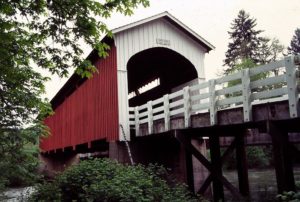 Located just 20 minutes south of Eugene, Cottage Grove is known as the “Covered Bridge Capital of the West”. The State of Oregon Covered Bridge Scenic Byway was designated by ODOT in 2000. This is a fun day trip for your family and a great opportunity to check out some local history. Another way to enjoy these bridges is to visit the Oregon Covered Bridge Festival, held in historic downtown Cottage Grove each year. The festival offers tours of the area’s covered bridges, which include:
Located just 20 minutes south of Eugene, Cottage Grove is known as the “Covered Bridge Capital of the West”. The State of Oregon Covered Bridge Scenic Byway was designated by ODOT in 2000. This is a fun day trip for your family and a great opportunity to check out some local history. Another way to enjoy these bridges is to visit the Oregon Covered Bridge Festival, held in historic downtown Cottage Grove each year. The festival offers tours of the area’s covered bridges, which include:
Mosby Creek Bridge: Constructed in 1920, this is the oldest bridge in Lane County. It is a single lane bridge, which remains open to traffic today. The bridge was restored in 1990.
Currin Bridge: This colorful bridge was constructed in 1925 and restored in 1995. Sporting colorful red sides and white portals, it is the only two-toned covered bridge in Oregon. Currin Bridge stands as a replacement to an earlier covered bridge built in 1883 by a prominent local bridge builder, Nels Roney.
Chambers Railroad Bridge: Built in 1925, Chambers Railroad Bridge is the last covered railroad bridge in Oregon. This bridge is listed in the National Registry of Historic Places. It was originally constructed by lumberman J.E. Chambers to cross the Coast Fork of the Willamette from his sawmill to the timberlands west of town. In 2011, the bridge was fully restored, and now functions as a pedestrian and bike bridge.
Stewart Bridge: Constructed in 1930 and restored in 1996. The deep water below the bridge is considered one of the best swimming holes in Lane county.
Dorena Bridge: This bridge was built in 1949, after the construction of Dorena Dam on the Row River. At the time, Dorena Bridge tied the roads on the north and south sides of the newly created Dorena lake. Although it is no longer open to traffic, Dorena Bridge is a popular site for weddings in Oregon.
Centennial Bridge: One of the more modern bridges on the list, Centennial Bridge was constructed in 1997 to celebrate Cottage Grove’s centennial. It rests on abutments of the old Main Street Bridge, which stood until the 1950s. It was constructed by the volunteer labor of local citizens, and utilized materials from a pair of old bridges which had been demolished by the county. This bridge is only open to pedestrians.
Swinging Bridge: Swinging Bridge was originally built for foot and bicycle traffic. In the past, children used this bridge to cross the Coast Fork on their daily walk to school. The present Swinging Bridge is but one of many built over the years in this exact location. Some of the early bridges built on this site could be made to swing side-to-side. Although it is a stationary bridge today, the name remains as a tribute to the bridge’s “swinging” past.
